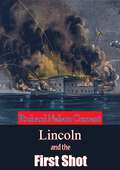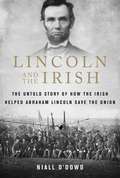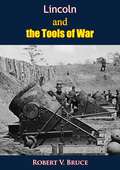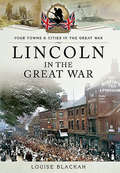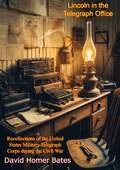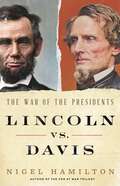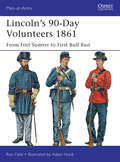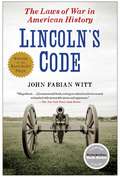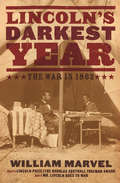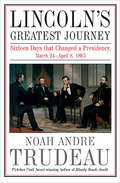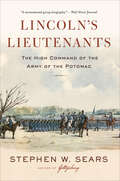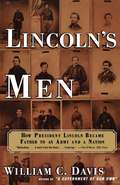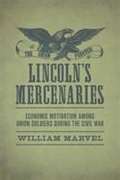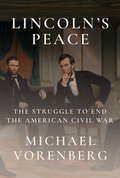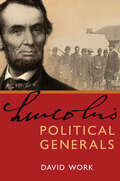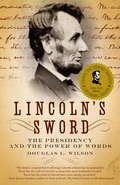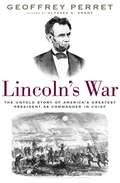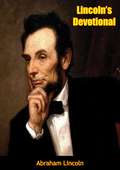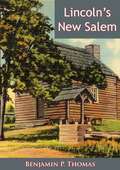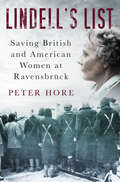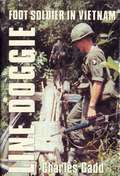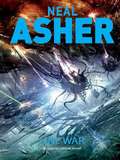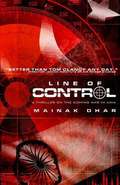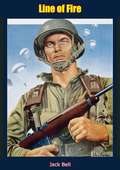- Table View
- List View
Lincoln and the First Shot
by Richard Nelson CurrentLincoln and the First Shot by Richard Nelson Current examines the tense period leading up to the outbreak of the American Civil War, focusing on President Abraham Lincoln's handling of the secession crisis. With Fort Sumter as the centerpiece of the drama, Current explores how Lincoln navigated the treacherous waters of diplomacy, public opinion, and military strategy to maintain the Union without initiating open conflict.The book delves deeply into Lincoln's political acumen and his efforts to balance firmness with restraint in the face of Southern provocations, particularly those of the newly formed Confederate government. By drawing on an array of historical sources, Current paints a nuanced portrait of Lincoln as a leader determined to preserve peace as long as possible while standing firm on the principle that secession was unconstitutional.The narrative highlights critical moments, such as Lincoln's decision to resupply Fort Sumter, revealing the careful calculations behind his actions and the eventual Confederate attack that ignited the war. Lincoln and the First Shot offers a gripping analysis of the president's early leadership, providing valuable insight into the complexities of his decisions and the forces that ultimately led to the first battle of the Civil War.
Lincoln and the Irish: The Untold Story of How the Irish Helped Abraham Lincoln Save the Union
by Niall O'DowdAn unprecedented narrative of the relationship that swung the Civil War. When Pickett charged at Gettysburg, it was the all-Irish Pennsylvania 69th who held fast while the surrounding regiments broke and ran. And it was Abraham Lincoln who, a year earlier at Malvern Hill, picked up a corner of one of the Irish colors, kissed it, and said, “God bless the Irish flag.” Lincoln and the Irish untangles one of the most fascinating subtexts of the Civil War: Abraham Lincoln’s relationship with the men and women coming to America to escape the Irish famine. Renowned Irish-American journalist Niall O’Dowd gives unprecedented insight into a relationship that began with mutual disdain. Lincoln saw the Irish as instinctive supporters of the Democratic opposition, while the Irish saw the English landlord class in Lincoln’s Republicans. But that dynamic would evolve, and the Lincoln whose first political actions included intimidating Irish voters at the polls would eventually hire Irish nannies and donate to the Irish famine fund. When he was voted into the White House, Lincoln surrounded himself with Irish staff, much to the chagrin of a senior aide who complained about the Hibernian cabal. And the Irish would repay Lincoln’s faith—their numbers and courage would help swing the Civil War in his favor, and among them would be some of his best generals and staunchest advocates.
Lincoln and the Tools of War
by Robert V. Bruce Benjamin P. ThomasFirst published in 1956, this is an account of the arming of the Union forces in the Civil War, and of Lincoln’s part in it. It has never been told in any comprehensive way before, and shows Lincoln in a new and engaging light.Lincoln was determined to win the war, yet his generals seemed unable to give him a victory, so he reasoned that a more efficient weapon would have to be invented. However, his main opponent, General James W. Ripley, who sat in charge of army ordnance, believed the war would be short and didn’t want a vast supply of expensive arms left over. Standardized guns and ammunition made supplying the troops in the field easier.Lincoln was in the thick of it. He wanted mortar boats to help open the upper Mississippi as they had helped Porter take New Orleans. When he discovered a big snafu had delayed production, one J. D. Mills came to Washington with a crude machine gun that was soon christened the coffee-mill gun.Probably the biggest and longest controversy involved muzzle-loading rifles—favoured by Ripley—and breech-loading rifles—the Soldier’s choice, as he could lie down and load a breechloader at least five times as fast as a muzzle-loader. In addition to these and other standard arms, the inventors offered a wide catalogue of innovations: rockets, steam guns, liquid fire, a submarine, explosive bullets, a proposed poison gas, and so on down to the fantastic.This book is a big American story of Washington in wartime, and it will appeal to everybody who ever had any contact with the armed services. For the specialist, it offers quite a quantity of previously unpublished material. Its biggest merit is, however, that it is just plain fascinating reading, the kind of book no one should start late in the evening if he wants any sleep.
Lincoln in the Great War (Your Towns & Cities in the Great War)
by Louise BlackahLincoln produced many heroes during WW1 including, Wing Commander Fiennes who was the Commanding Officer of 38 Squadron from 1916 to 1917 flying FE2b aircraft (known as the 'Fees') on patrol against raiding German Zeppelins over Lincolnshire and the surrounding counties. Also, a winged version of the Lincoln Imp adorned many of the First World War aircraft including the famous Sopwith Camel, manufactured extensively by Lincoln firms Clayton and Shuttleworth, Robeys and Ruston Proctor.This book also looks at how the experience of war impacted on the City, from the initial enthusiasm for sorting out the German Kaiser in time for Christmas 1914, to the gradual realization of the enormity of human sacrifice the families of Lincoln were committed to as the war stretched out over the next four years. The Great War affected everyone. At home there were wounded soldiers in military hospitals, refugees from Belgium and later on German prisoners of war. There were food and fuel shortages and disruption to schooling. The role of women changed dramatically and they undertook a variety of work undreamed of in peacetime. Extracts from contemporary letters reveal their heroism and give insights into what it was like under battle conditions, particularly from those of the Lincolnshire Yeomanry.
Lincoln in the Telegraph Office: Recollections of the United States Military Telegraph Corps during the Civil War
by David Homer Bates“As the Civil War raged, President Abraham Lincoln spent many hours in the War Department’s telegraph office, where he received all his telegrams. Morning, noon, and night Lincoln would visit the small office to receive the latest news from the armies at the front. The place was a refuge for the president, who waited for incoming dispatches and talked while they were being deciphered.David Homer Bates, one of the first military telegraphers, recollects those presidential visits during times of crisis. Lincoln in the Telegraph Office, originally published in 1907, shows history in the making and personalities at their most unguarded: Lincoln, Secretary of War Edwin Stanton, Andrew Carnegie, General George McClellan, and many others. The reader is with Lincoln at the scene of dramatic tidings: of the Northern disasters at Bull Run, of Meade’s victory at Gettysburg, of Grant’s capture of Richmond. Lincoln wrote the first draft of the Emancipation Proclamation at the telegraph office, and from there the news of his assassination was relayed. Wartime human-interest anecdotes, the wonder of the new technology, the unraveling of ciphers and codes, conspiracies and rumors, a heightened sense of onrushing events, the tragedy of Good Friday 1865—all are conveyed in this classic of Lincolniana.”-Print ed.
Lincoln vs. Davis: The War of the Presidents
by Nigel HamiltonFrom the New York Times bestselling presidential biographer comes the greatest untold story of the Civil War: how two American presidents faced off as the fate of the nation hung in the balance—and how Abraham Lincoln came to embrace emancipation as the last, best chance to save the Union. Of all the books written on Abraham Lincoln, there has been one surprising gap: the drama of how the &“railsplitter&” from Illinois grew into his critical role as U.S. commander-in-chief, and managed to outwit his formidable opponent, Jefferson Davis, in what remains history's only military faceoff between rival American presidents. Davis was a trained soldier and war hero; Lincoln a country lawyer who had only briefly served in the militia. Confronted with the most violent and challenging war ever seen on American soil, Lincoln seemed ill-suited to the task: inexperienced, indecisive, and a poor judge of people&’s motives, he allowed his administration's war policies to be sabotaged by fickle, faithless cabinet officials while entrusting command of his army to a preening young officer named George McClellan – whose defeat in battle left Washington, the nation&’s capital, at the mercy of General Robert E. Lee, Davis&’s star performer. The war almost ended there. But in a Shakespearean twist, Lincoln summoned the courage to make, at last, a climactic decision: issuing as a &“military necessity&” a proclamation freeing the 3.5 million enslaved Americans without whom the South could not feed or fund their armed insurrection. The new war policy doomed the rebellion—which was in dire need of support from Europe, none of whose governments now would dare to recognize rebel &“independence&” in a war openly fought over slavery. The fate of President Davis was sealed. With a cast of unforgettable characters, from first ladies to fugitive coachmen to treasonous cabinet officials, Lincoln vs. Davis is a spellbinding dual biography from renowned presidential chronicler Nigel Hamilton: a saga that will surprise, touch, and enthrall.
Lincoln's 90-Day Volunteers 1861
by Adam Hook Ron FieldOn April 15, the day after the fall of Fort Sumter, President Abraham Lincoln issued a call for 75,000 volunteers to enlist for three months' service to defend the Union. Featuring specially commissioned full-color artwork, this is the engaging story of the first wave of soldiers who volunteered to defend and preserve the Union in 1861, based on detailed research in US sources, including many eye-witness accounts of their very varied uniforms and equipment.When war broke out with the Confederate bombardment of Fort Sumter, South Carolina, on April 12-14, 1861, the regular US Army numbered just 16,000 troops, most of them scattered widely, and far from what would clearly become the main theater of operations between the two capitals - Washington, DC, and Richmond, Virginia. It was at this time Lincoln called for a three-month enlistment from volunteers. The 90-day period was, of course, entirely unrealistic, and would be followed by further and much more extensive mobilizations; but for the first few months, when Washington itself was in real danger, the defense of the capital depended on a hastily gathered army of militiamen and volunteers from those states that declared their immediate loyalty to the Union. These units were mostly entirely inexperienced, barely trained, weakly officered, and provided with the most motley uniforms, equipage, and weapons. Nevertheless, they bought the Union time during the first vital months. This period ended with the First Battle of Bull Run (Manassas) on July 21, at which only some 2,000 of General McDowell's 28,500 Union troops were regulars. This ground-breaking study draws upon a very wide range of period sources to describe and illustrate the actual appearance of this diverse and colorful force, including photographs, eyewitness accounts in period newspapers and letters, the reports of government agents, and the records of the many manufacturers who received orders to clothe and equip their state troops. The units were composed of separate companies drawn from both wealthy and poorer communities, so varied widely in style, from copies of fashionable French uniforms to plain working-men's clothing. There were no rules at this date specifying that the North should wear blue and the South gray, and the extremely mixed appearance of both armies caused much dangerous confusion. Fully illustrated with specially commissioned artwork and rare period illustrations, this engaging account brings to life the first wave of volunteers who stepped forward to defend and preserve the Union in 1861.
Lincoln's Code
by John Fabian WittIn the fateful closing days of 1862, three weeks before Emancipation, the administration of Abraham Lincoln commissioned a code setting forth the laws of war for the armies of the United States. The code announced standards of civilized conduct in wartime concerning issues such as torture, prisoners of war, civilians, spies, and slaves. The code Lincoln approved ultimately shaped the course of the Civil War. And when the war was over, the same code reshaped warfare the world over. By the twentieth century, the 157 articles of Lincoln's code had become the basis of a new international law of war. European powers adopted the American code. International agreements like the Geneva Conventions incorporated and expanded it. In this pathbreaking and deeply original book, John Fabian Witt tells the hidden story of the laws of war in the first century of the United States-and of the extraordinary code that emerged from it to change the course of world history. Lincoln's Code is the haunting and inspiring story of an idea in American history: the idea that conduct in war can be regulated by law. For many, the very idea of a law for war has seemed like an oxymoron. But with sweep and vitality, Witt unfolds the story of the cast of characters who invented the modern laws of war. Washington, Jefferson, and Franklin championed Enlightenment rules for civilized warfare. James Madison went to war in 1812 to vindicate them. Indian conflicts challenged and distorted them. The Mexican War quietly revolutionized them. In the Civil War, Lincoln and a small band of now forgotten figures helped remake those same laws to support Emancipation and advance the Union war effort. Three decades later, a new generation of Americans went into a war of American empire in the Philippines equipped with the very rules Lincoln had laid down. In beautifully crafted prose, Witt brings to life the soldiers and the presidents, the war makers and the pacifists, the Indians and the slaves, the cynics, the utopians, and the pragmatists who struggled with enemies and with one another to shape the United States' vision of the laws of war. A narrative of expansive range and significance, Lincoln's Code depicts the drama of armed conflict and the anguish of human beings grappling with such vexing questions as whether prisoners could be executed; whether there were rules in Indian wars; whether military commissions could try unlawful combatants; whether torture might ever be justified; and whether slaves could be freed in wartime. The code Lincoln issued prohibited cruelty and the infliction of pain for its own sake but left room for vast destruction in the name of a just cause. It condoned the devastation inflicted in Sherman's march to the sea. Yet it also provided a moral foundation for Emancipation and insisted that doing the right thing in situations of grave crisis was indispensable to the legitimacy of modern armies. Witt's engrossing exploration of the dilemmas at the heart of the laws of war is a prehistory of our own era. Today the world once again confronts raging legal and moral controversy over the conduct of war. Lincoln's Code reveals that the controversies of the twenty-first century have roots going back to the beginnings of American history. In a time of heated controversy about the nation's conduct in wartime, Lincoln's Code is a compelling story of ideals under pressure and a landmark contribution to our understanding of the American experience.
Lincoln's Code: The Laws of War in American History
by John Fabian WittPulitzer Prize FinalistBancroft Prize WinnerABA Silver Gavel Award WinnerA New York Times Notable Book of the YearIn the closing days of 1862, just three weeks before Emancipation, the administration of Abraham Lincoln commissioned a code setting forth the laws of war for US armies. It announced standards of conduct in wartime--concerning torture, prisoners of war, civilians, spies, and slaves--that shaped the course of the Civil War. By the twentieth century, Lincoln's code would be incorporated into the Geneva Conventions and form the basis of a new international law of war. In this deeply original book, John Fabian Witt tells the fascinating history of the laws of war and its eminent cast of characters--Washington, Jefferson, Franklin, Madison, and Lincoln--as they crafted the articles that would change the course of world history. Witt's engrossing exploration of the dilemmas at the heart of the laws of war is a prehistory of our own era. Lincoln's Code reveals that the heated controversies of twenty-first-century warfare have roots going back to the beginnings of American history. It is a compelling story of ideals under pressure and a landmark contribution to our understanding of the American experience.
Lincoln's Darkest Year: The War in 1862
by William MarvelA portrait of a pivotal chapter in the Civil War, &“featuring scheming politicians, bumbling generals, and an increasingly disheartened Northern public&” (Brooks Simpson, author of Ulysses S. Grant: Triumph Over Adversity, 1822–1865). In Mr. Lincoln Goes to War, award-winning historian William Marvel focused on President Abraham Lincoln&’s first year in office. In Lincoln&’s Darkest Year, he paints a picture of 1862—again relying on recently unearthed primary sources and little-known accounts to offer newfound detail of this tumultuous period. Marvel highlights not just the actions but also the deeper motivations of major figures, including Gen. Ulysses S. Grant, Jefferson Davis, George B. McClellan, Stonewall Jackson, and, most notably, Lincoln himself. As the action darts from the White House to the battlefields and back, the author sheds new light on the hardships endured by everyday citizens and the substantial and sustained public opposition to the war. Combining fluid prose and scholarship with the skills of an investigative historical detective, Marvel unearths the true story of our nation&’s greatest crisis.
Lincoln's Greatest Journey: Sixteen Days that Changed a Presidency, March 24–April 8, 1865
by Noah Andre TrudeauMarch 1865: The United States was at a crossroads and, truth be told, Abraham Lincoln was a sick man. I am very unwell, he confided to a close acquaintance. A vast and terrible civil war was winding down, leaving momentous questions for a war-weary president to address. A timely invitation from General U. S. Grant provided the impetus for an escape to City Point, Virginia, a journey from which Abraham Lincoln drew much more than he ever expected. Lincolns Greatest Journey: Sixteen Days that Changed a Presidency, March 24 April 8, 1865, by Noah Andre Trudeau offers the first comprehensive account of a momentous time.Lincoln traveled to City Point, Virginia, in late March 1865 to escape the constant interruptions in the nations capital that were carrying off a portion of his vitality, and to make his personal amends for having presided over the most destructive war in American history in order to save the nation. Lincoln returned to Washington sixteen days later with a renewed sense of purpose, urgency, and direction that would fundamentally shape his second term agenda.Previous coverage of this unprecedented triphis longest break from the White House since he had taken officehas been sketchy at best, and often based on seriously flawed sources. Lincolns Greatest Journey represents the most extensively researched and detailed story of these decisive sixteen days at City Point in a narrative laden with many heretofore unpublished accounts. The richly shaped prose, a hallmark of Trudeaus pen, rewrites much of the heretofore misunderstood story of what really happened to Lincoln during this time.A fresh, more complete picture of Lincoln emerges. This is Lincoln at a time of great personal and national changethe story of how he made peace with the past and became firmly future-focused, all set against a dramatically new narrative of what really happened during those last weeks of his life. It infuses the well-worn Lincoln narrative with fresh sources to fundamentally change an often-told story in ways large and small. Rather than treat Lincoln as a dead man walking when he returns to Washington, Trudeau paints him as he surely wasa changed man profoundly influenced by all that he experienced while at City Point.Lincolns Greatest Journey represents an important addition to the Lincoln saga. The conventional wisdom that theres nothing new to be learned about Lincoln is due for a major reset.
Lincoln's Lieutenants: The High Command of the Army of the Potomac
by Stephen W. SearsA multilayered group biography of the Civil War commanders who led the Army of the Potomac: “a staggering work . . . by a masterly historian” (Kirkus, starred review).The high command of the Army of the Potomac was a changeable, often dysfunctional band of brothers, going through the fires of war under seven commanding generals in three years, until Grant came east in 1864. The men in charge all too frequently appeared to be fighting against the administration in Washington instead of for it, increasingly cast as political pawns facing down a vindictive congressional Committee on the Conduct of the War.President Lincoln oversaw, argued with, and finally tamed his unruly team of lieutenants as the eastern army was stabilized by an unsung supporting cast of corps, division, and brigade generals. With characteristic style and insight, Stephen Sears brings these courageous, determined officers, who rose through the ranks and led from the front, to life and legend. “A masterful synthesis . . . A narrative about amazing courage and astonishing gutlessness . . . It explains why Union movements worked and, more often, didn’t work in clear-eyed explanatory prose that’s vivid and direct.” —Chicago Tribune
Lincoln's Men: How President Lincoln Became Father To an Army an
by William C. DavisI sit down to write you (a Soldier's Friend!)...My kind Friend of Friends you have the power to help me a grate deal...I have great Confidence in our Good President hoe has dun a grate deal for us poor Soldiers... So wrote Private Joe Hass to Abraham Lincoln, February 20, 1864. Like an extraordinary number of his fellow Union soldiers, he loved Lincoln as a father. Lincoln inspired feelings unlike those instilled by any previous commander-in-chief in America. In Lincoln's Men, William C. Davis draws on thousands of unpublished letters and diaries to tell the hidden story of how a new and untested president could become "Father Abraham" throughout both the army and the North as a whole. How did the Army of the Potomac, yearning for the grandeur of McClellan, turn instead to the comfort of Old Abe, and how was this change of loyalty crucial to final victory? How did Lincoln inspire the faith and courage of so many shattered men, wandering the inferno of Shiloh or entrenched in the siege of Vicksburg? Why did soldiers visiting Washington feel free to stroll into the White House and sit down to relax, as if it were their own home? Davis removes layers of mythmaking to recapture the moods and feelings of an army facing one of history's bloodiest conflicts. Tracing the popular fate of decisions to invoke conscription, to fire McClellan, and to free the slaves, Lincoln's Men casts a new light on our most famous president -- the light, that is, of the peculiar mass medium that was the Union Army. A motley band of talkers and letter writers, the soldiers spread news of Lincoln's appearances like wildfire, chortling at his ungainly posture in the saddle, rushing up to shake his hand and talk to him. The volunteers knew they could approach "Old Abe," "Honest Abe," "Uncle Abe," and "Father Abraham," and they cheered him thunderously. "The men could not be restrained from so honoring him," said Private Rice Bull. "He really was the ideal of the Army." The story of the making of Father Abraham is the story of America's second revolution, its rebirth. As one Union soldier and journalist put it, "Washington taught the world to know us, Lincoln taught us to know ourselves. The first won for us our independence, the last wrought out our manhood and self-respect."
Lincoln's Mercenaries: Economic Motivation Among Union Soldiers During the Civil War (Conflicting Worlds: New Dimensions of the American Civil War)
by William MarvelIn this book, the author considers whether poor northern men bore the highest burden of military service during the American Civil War. Examining data on median family wealth from the 1860 United States Census, Marvel reveals the economic conditions of the earliest volunteers from each northern state during the seven major recruitment and conscription periods of the war. The results consistently support the conclusion that the majority of these soldiers came from the poorer half of their respective states' population, especially during the first year of fighting. A fascinating, comprehensive study, the book illustrates how an array of social and economic factors drove poor northern men to rely on military wages to support themselves and their families during the war.
Lincoln's Peace: The Struggle to End the American Civil War
by Michael VorenbergOne historian&’s journey to find the end of the Civil War—and, along the way, to expand our understanding of the nature of war itself and how societies struggle to draw the line between war and peaceWe set out on the James River, March 25, 1865, aboard the paddle steamboat River Queen. President Lincoln is on his way to General Grant&’s headquarters at City Point, Virginia, and he&’s decided he won&’t return to Washington until he&’s witnessed, or perhaps even orchestrated, the end of the Civil War. Now, it turns out, more than a century and a half later, historians are still searching for that end. Was it April 9, at Appomattox, as conventional wisdom holds, where Lee surrendered to Grant in Wilmer McLean&’s parlor? Or was it ten weeks afterward, in Galveston, where a federal commander proclaimed Juneteenth the end of slavery? Or perhaps in August of 1866, when President Andrew Johnson simply declared &“the insurrection is at an end&”? That the answer was elusive was baffling even to a historian of the stature of Michael Vorenberg, whose work served as a key source of Steven Spielberg&’s Lincoln. Vorenberg was inspired to write this groundbreaking book, finding its title in the peace Lincoln hoped for but could not make before his assassination. A peace that required not one but many endings, as Vorenberg reveals in these pages, the most important of which came well more than a year after Lincoln&’s untimely death. To say how a war ends is to suggest how it should be remembered, and Vorenberg&’s search is not just for the Civil War&’s endpoint but for its true nature and legacy, so essential to the American identity. It&’s also a quest, in our age of &“forever wars,&” to understand whether the United States's interminable conflicts of the current era have a precedent in the Civil War—and whether, in a sense, wars ever end at all, or merely wax and wane.
Lincoln's Political Generals
by David WorkAt the beginning of the Civil War, President Abraham Lincoln sought to bind important political leaders to the Union by appointing them as generals. The task was formidable: he had to find enough qualified officers to command a military that would fight along a front that stretched halfway across the continent. West Point hadn't graduated enough officers, and many of its best chose to fight for the Confederacy. Lincoln needed loyal men accustomed to organization, administration, and command. He also needed soldiers, and political generals brought with them their constituents and patronage power. As the war proceeded, the value of the political generals became a matter of serious dispute. Could politicians make the shift from a political campaign to a military one? Could they be trusted to fight? Could they avoid destructive jealousies and the temptations of corruption? And with several of the generals being Irish or German immigrants, what effect would ethnic prejudices have on their success or failure? In this book, David Work examines Lincoln's policy of appointing political generals to build a national coalition to fight and win the Civil War. Work follows the careers of sixteen generals through the war to assess their contributions and to ascertain how Lincoln assessed them as commander-in-chief. Eight of the generals began the war as Republicans and eight as Democrats. Some commanded armies, some regiments. Among them were some of the most famous generals of the Union--such as Francis P. Blair Jr., John A. Dix, John A. Logan, James S. Wadsworth--and others whose importance has been obscured by more dramatic personalities. Work finds that Lincoln's policy was ultimately successful, as these generals provided effective political support and made important contributions in military administration and on the battlefield. Although several of them proved to be poor commanders, others were effective in exercising influence on military administration and recruitment, slavery policy, and national politics.
Lincoln's Sword
by Douglas L. WilsonWidely considered in his own time as a genial but provincial lightweight who was out of place in the presidency, Abraham Lincoln astonished his allies and confounded his adversaries by producing a series of speeches and public letters so provocative that they helped revolutionize public opinion on such critical issues as civil liberties, the use of black soldiers, and the emancipation of slaves. This is a brilliant and unprecedented examination of how Lincoln used the power of words to not only build his political career but to keep the country united during the Civil War.From the Trade Paperback edition.
Lincoln's War: The Untold Story of America's Greatest President as Commander-In-Chief
by Geoffrey PerretThis is a readable and yet scholarly work which serves as both history and biography. "Incredible as it may seem to us, when Lincoln became president, there was still a question as to whether the president, even acting as commander in chief, had the power to determine military policy. It fell to Lincoln to create the role of commander in chief. This book tells how he did that and how, in so doing, he created the modern presidency."
Lincoln’s Devotional: The Believer's Daily Treasure
by Abraham LincolnThe discovery of Abraham Lincoln’s personal, signed copy of a charming “vest-pocket” devotional has excited the public and historians alike—for here is new testimony to the depth of Lincoln’s faith, new light in an area previously clouded by uncertainty.In his moving introduction to this faithful edition of the 100-year-old book of daily Scriptural messages and inspirational verse, Carl Sandburg knits together fact and conjecture about Lincoln’s religious feelings. We are able to picture Abraham Lincoln carrying this little volume with him as he traveled the old Eighth Circuit; we learn of his familiarity with verses he could encounter in its pages.LINCOLN’S DEVOTIONAL contains a facsimile of Lincoln’s signature on the flyleaf, as he wrote it in his own copy.
Lincoln’s New Salem
by Benjamin P. ThomasOriginally published in 1956, in this book Benjamin P. Thomas tells the story of the village where Abraham Lincoln lived from 1831 to 1837. His three-part examination of the village often referred to as Lincoln’s “Alma Mater” features the founding and early history of New Salem, Lincoln’s impact on the village and its effect on him, and the story of the Lincoln legend and the reconstruction of the town.Thomas argues convincingly that New Salem was the town where Lincoln acquired faith in himself, faith in people. At 22 the future president drifted into town seeking to become a blacksmith. Thomas introduces us to the people who created New Salem and who knew, influenced, and befriended Lincoln.Thomas highlights Lincoln’s arrival, his relationships with his neighbors, his important wrestling match with Jack Armstrong, his self-education, his quiet career as an Indian fighter, his experience as a postmaster largely indifferent to postal regulations, his financial woes as a businessman, his loyal friends who often came to his aid, and his election to the legislature.This colorful history closes with a discussion of the Lincoln legend. The truth of the stories is unimportant. What matters is that the growing Lincoln legend prompted the gradual realization that New Salem was not a dismal mire from which President Lincoln had had to extricate himself but was, in fact, an energizing force. This realization led to research and finally to the restoration of New Salem, which began in 1932.“No other portion of Lincoln’s life lends itself so readily to intensive study of his environment as do his six years at New Salem.”—Benjamin P. Thomas, Foreword
Lindell's List: Saving British and American Women at Ravensbrück
by Peter HoreAlready a decorated heroine of the First World War, British-born Mary Lindell, Comtesse de Milleville, was one of the most colourful and courageous agents of the Second World War, yet her story has almost been forgotten. Evoking the spirit of Edith Cavell, and taking the German occupation of Paris in 1940 as a personal affront, she led an escape line for patriotic Frenchmen and British soldiers. After imprisonment, escape to England, a secret return to France and another arrest, she began to witness the horrors of German-run prisons and concentration camps. In April 1945, a score of British and American women emerged from the Women’s Hell – Ravensbrück concentration camp – who had been kept alive by the willpower and the strength of one woman, Mary Lindell. She combined a passion for adventure with blunt speech and persistently displayed the greatest personal bravery in the face of great adversity. To counter German claims that they had no British or American prisoners, Mary smuggled out a plea for rescue and produced her list from her pinafore pocket, compiled in secret from the camp records. This vital list contained the names of captured women, many of whom were agents of British Military Intelligence, the Special Operations Executive or the French Resistance. Poignantly supported by first-hand testimony, Lindell’s List tells the moving story of Mary Lindell’s heroic leadership and the endurance of a group of women who defied the Nazis in the Second World War.
Line Doggie: Foot Soldier in Vietnam
by Charles GaddCharles Gadd served in Vietnam in late 1967 and 1968 and had experiences very similar to what most enlisted men endured. He describes the mud, blood, leeches, loss of friends, and low morale due to constant harassment by guerrillas. The author, a squad leader with the 101st Airborne, was wounded twice and saw nearly constant action in the Central Highlands. This memoir is a vivid and accurate description of the Vietnam War.
Line War
by Neal AsherThe Polity is under attack from a 'melded' AI entity with control of the lethal Jain technology, yet the attack seems to have no coherence. When one of Erebus's wormships kills millions on the world of Klurhammon, a high-tech agricultural world of no real tactical significance, agent Ian Cormac is sent to investigate, though he is secretly struggling to control a new ability no human being should possess . . . and beginning to question the motives of his AI masters. Further attacks and seemingly indiscriminate slaughter ensue, but only serve to bring some of the most dangerous individuals in the Polity into the war. Mr Crane, the indefatigable brass killing machine sets out for vengeance, while Orlandine, a vastly-augmented haiman who herself controls Jain technology, seeks a weapon of appalling power and finds allies from an ancient war. Meanwhile Mika, scientist and Dragon expert, is again kidnapped by that unfathomable alien entity and dragged into the heart of things: to wake the makers of Jain technology from their five-million-year slumber. But Erebus's attacks are not so indiscriminate, after all, and could very well herald the end of the Polity itself . . .
Line of Control A Thriller on the Coming War in Asia: A Thriller On The Coming War In Asia
by Mainak DharIt is 2012, and the world is a more dangerous place than ever before. Revolutions have swept aside one Middle Eastern regime after another. A regime allied to Al Qaeda has swept to power in Saudi Arabia, and uses its oil wealth and modern arsenal to further spread Jihad around the world. Yet another military coup brings a fundamentalist regime to power in Pakistan, which initiates an audacious plan to strike the first blow in this new global Jihad. As unprecedented terror attacks stun India, the stage is set for a conflict that brings the Indian subcontinent to the brink of a nuclear annihilation.
Line of Fire
by Jack BellTHE STORY OF WORLD WAR II’S LOWEST COMMON DENOMINATOR—THE FIGHTING MANOriginally published in 1948, this is the fascinating account of U.S. soldiers fighting in East Asia and Europe, as seen firsthand by an American journalist, Jack Bell of the Chicago Daily News.“Jack Bell spent his time with the fighting men, usually where the fighting was the thickest. He knew the troops and lived with them. He was the kind of a correspondent who would patrol the frontal areas, get voluminous motes, go back to his typewriter and write enough stuff to fill his requirements for a week, then go out again for another basketful of names and hometowns.“He saw and knew the war as it really was—the machine gunner sweating out the next attack; the advancing BAR man clinging closely to a stone wall; the lonely man on an outpost listening with every pore of his body; the exhilaration and excitement of intense firing and fighting and the depressing feeling that came with surveying the killed and wounded in the silence that followed. He knew all of it and much more. He knew the people that fought it, their fear, their worries, and their moments of greatness. And this, finally, is the essence of war. For it is a composite of men, gun crews, air crews, seamen, and thousands of small fighting teams, all of whom regardless of their origins and fears do their jobs when the chips are down. It is these things rather than broad arrows on bright maps with thumb smudged evidences of staff cerebrations that is war. And this was Jack Bell’s war.”—James M. Gavin
